Post-Metal Fusion reshapes contemporary soundscapes by merging heavy metal with atmospheric elements. This article explores influential releases that define the genre, regional interpretations that infuse local sounds, and collaborations that expand creative boundaries. It also examines the thematic depth of lyrics and essential production techniques that enhance immersive experiences. Emerging artists face challenges in promoting their unique soundscapes amidst a competitive landscape.

How does Post-Metal Fusion shape contemporary soundscapes?
Post-Metal Fusion significantly shapes contemporary soundscapes by blending heavy metal with atmospheric elements. This genre creates immersive experiences through layered instrumentation and dynamic contrasts. Influential releases like “Oceanic” by Isis and “Dopesmoker” by Sleep exemplify how Post-Metal Fusion integrates diverse influences, transforming traditional metal forms. The unique attribute of this genre is its capacity for emotional depth, often evoking feelings of introspection and vastness. As a result, Post-Metal Fusion continues to inspire artists across various genres, pushing the boundaries of sound and composition.
What are the defining characteristics of Post-Metal Fusion?
Post-Metal Fusion is characterized by its blending of heavy metal elements with atmospheric and experimental sounds. Key features include layered guitar textures, diverse vocal styles, and an emphasis on mood and emotion. Influential releases often showcase complex song structures and a mix of genres, highlighting the unique attribute of sonic exploration. The genre’s soundscapes evoke a sense of depth, creating immersive listening experiences that differentiate it from traditional metal forms.
How do atmospheric elements influence Post-Metal soundscapes?
Atmospheric elements significantly shape Post-Metal soundscapes by creating immersive auditory experiences. The genre often incorporates ambient textures, heavy guitar riffs, and dynamic contrasts, reflecting environmental influences. For example, natural sounds like wind or rain can enhance the emotional depth and complexity of compositions. Unique attributes, such as the use of reverb and delay effects, contribute to a spacious sound that evokes vast landscapes. Influential releases, like “Oceanic” by Isis, exemplify how atmospheric elements can transform and elevate the listening experience in Post-Metal.
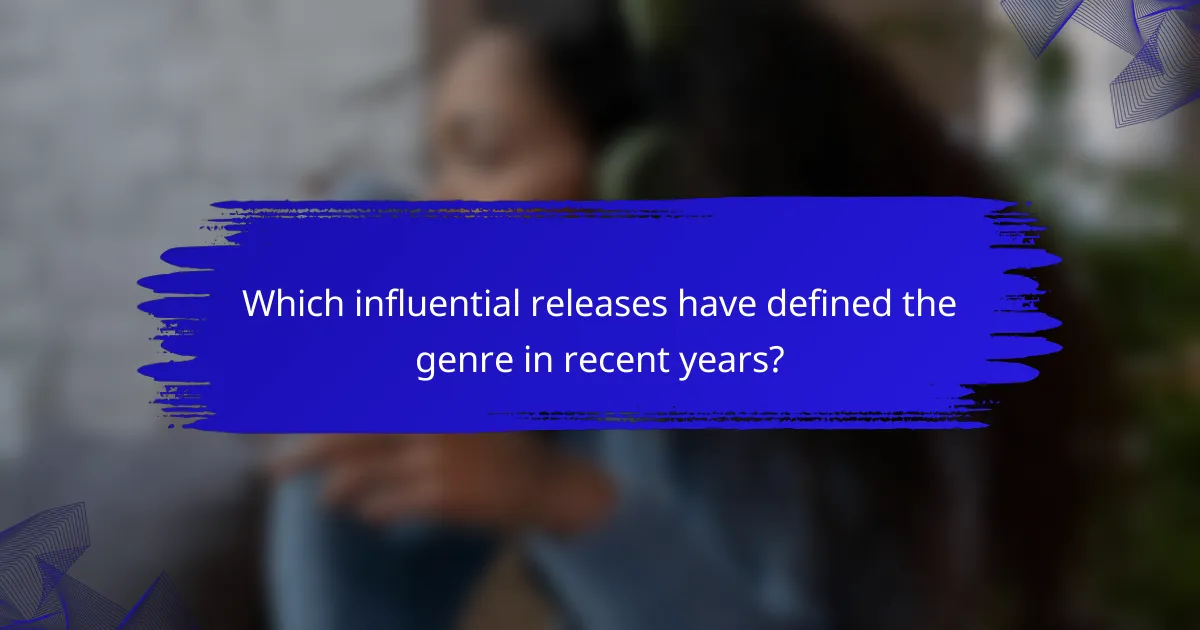
Which influential releases have defined the genre in recent years?
Recent influential releases in post-metal fusion have expanded soundscapes and defined the genre. Notable albums include “Celestial” by Russian Circles, which blends atmospheric elements with heavy riffs, and “A Dawn to Fear” by Cult of Luna, recognized for its immersive sound design. Additionally, “The Great Filter” by The Ocean showcases complex compositions that push genre boundaries. These works exemplify the evolving nature of post-metal, integrating diverse influences while maintaining core characteristics.
What impact did ‘Oceanic’ by Isis have on Post-Metal Fusion?
‘Oceanic’ by Isis significantly shaped Post-Metal Fusion by enhancing atmospheric soundscapes and integrating diverse musical influences. The album introduced intricate layering and dynamic shifts, establishing a template for future bands. Its impact is evident in the rise of similar artists who adopt its immersive qualities. The unique use of heavy yet melodic instrumentation set a new standard, influencing the genre’s evolution.
How did ‘The Mantle’ by Agalloch contribute to the genre’s evolution?
“The Mantle” by Agalloch significantly influenced post-metal by blending atmospheric soundscapes with diverse musical elements. This album introduced a unique fusion of black metal, folk, and post-rock, creating immersive auditory experiences. Its expansive compositions and emotional depth set new standards for the genre, inspiring countless artists. The incorporation of nature-inspired themes and dynamic shifts in tempo also contributed to the evolution of post-metal, encouraging experimentation and innovation within the genre.
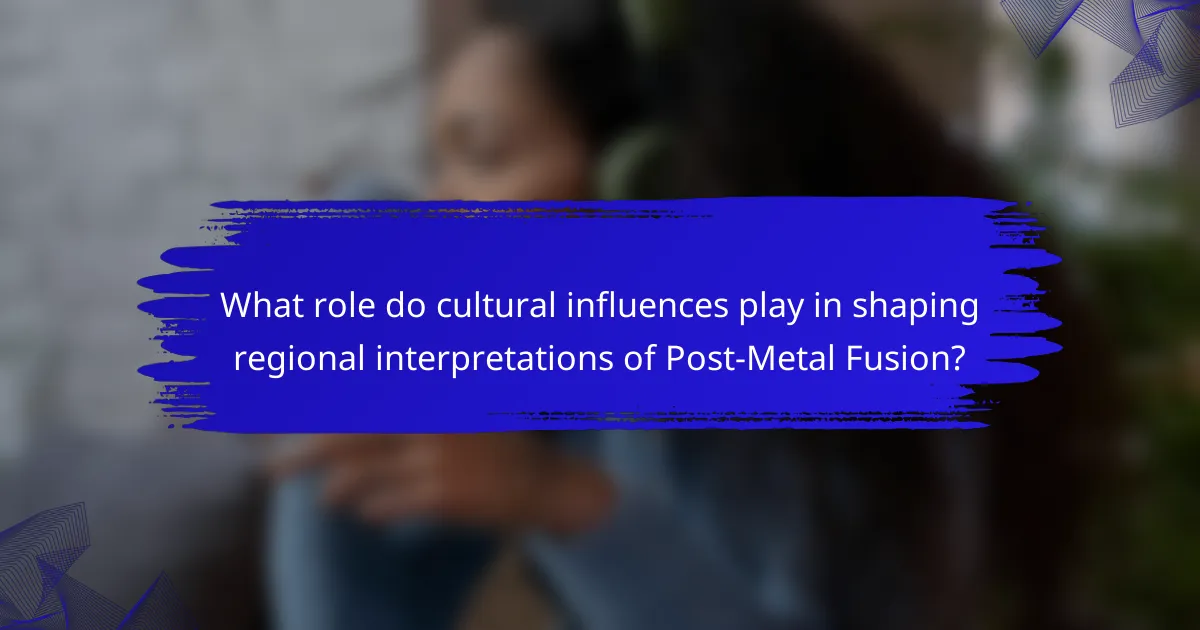
What role do cultural influences play in shaping regional interpretations of Post-Metal Fusion?
Cultural influences significantly shape regional interpretations of Post-Metal Fusion by infusing local sounds and thematic elements. Each region integrates its unique musical heritage, resulting in diverse soundscapes. For example, Scandinavian bands often incorporate folk elements, while American groups may blend post-rock influences. These variations create a rich tapestry of styles and expressions, reflecting cultural identities. The interplay of regional characteristics and global trends fosters innovation within the genre, leading to distinctive releases that resonate with local audiences.
How does the Canadian scene differ from the UK and US interpretations?
The Canadian post-metal scene emphasizes atmospheric soundscapes and emotional depth, differing from UK and US interpretations. Canadian bands often incorporate nature-inspired elements, creating a unique auditory experience.
In contrast, UK post-metal tends to focus on heavier riffs and a more aggressive sound, while US interpretations often blend post-metal with other genres like hardcore. Influential Canadian releases like “Lift Your Skinny Fists Like Antennas to Heaven” by Godspeed You! Black Emperor showcase this distinct approach.
Overall, the Canadian scene’s emphasis on introspection and expansive sound contrasts sharply with the more aggressive styles found in the UK and US.
What unique elements do European bands bring to Post-Metal Fusion?
European bands contribute unique elements to Post-Metal Fusion through diverse cultural influences and experimental soundscapes. Their integration of traditional instruments and regional musical styles enriches the genre. Bands like Alcest and Les Discrets blend shoegaze with ambient elements, creating ethereal atmospheres. The use of dynamic contrasts and intricate layering adds depth, showcasing the emotional weight characteristic of European music. This fusion results in a distinct auditory experience that differentiates them from their global counterparts.
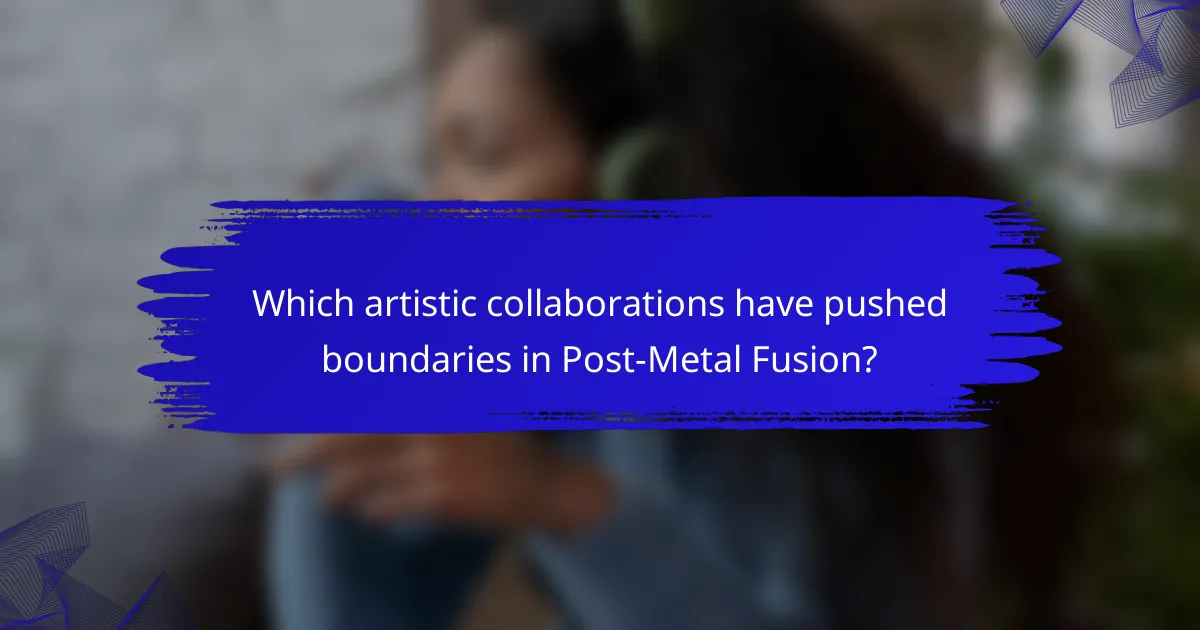
Which artistic collaborations have pushed boundaries in Post-Metal Fusion?
Collaborations in Post-Metal Fusion have expanded creative boundaries significantly. Notable partnerships include the work of bands like Neurosis and Cult of Luna, which blend heavy instrumentation with atmospheric elements. Another influential collaboration is between Amenra and the visual artist Hans Op de Beeck, merging soundscapes with immersive visuals. The album “A Dawn to Fear” by Cult of Luna features contributions from various artists, enhancing its depth. These collaborations illustrate the genre’s evolution and the fusion of diverse artistic expressions.
How do visual arts enhance the experience of Post-Metal music?
Visual arts significantly enhance the experience of Post-Metal music by creating immersive atmospheres that complement the genre’s complex soundscapes. The interplay between visual elements and music deepens emotional engagement. For example, album artwork often reflects the themes and moods of the music, influencing listeners’ interpretations. Additionally, live performances frequently incorporate visual art, such as projections or stage design, which enrich the auditory experience and create a multi-sensory environment. This synergy fosters a deeper connection between the audience and the music, making the experience more profound and memorable.
What are notable cross-genre collaborations that have emerged?
Notable cross-genre collaborations in post-metal fusion include influential releases that blend elements from various musical styles. For example, the collaboration between Neurosis and the band Tribes of Neurot created a unique soundscape merging post-metal with ambient influences. Another significant release is the album “Dopesmoker” by Sleep, which integrates elements of stoner rock and drone. Additionally, the collaboration between Cult of Luna and Julie Christmas on “Mariner” showcases a fusion of post-metal and progressive rock, enhancing the emotional depth of the genre. These collaborations exemplify how artists push boundaries, creating rich auditory experiences that resonate with diverse audiences.
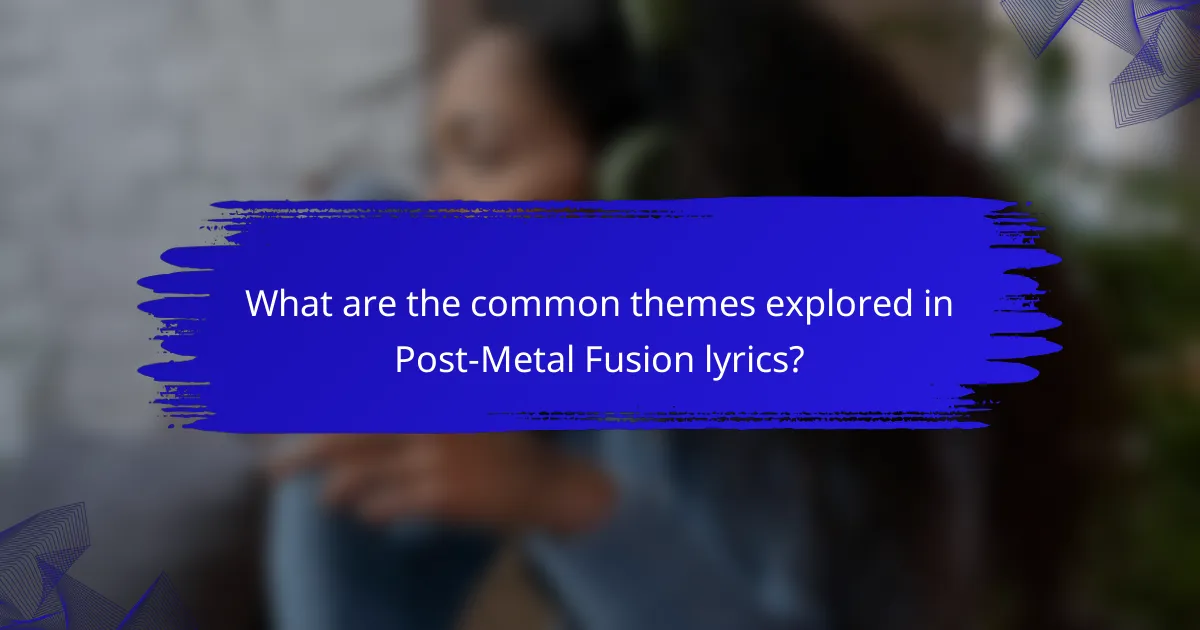
What are the common themes explored in Post-Metal Fusion lyrics?
Post-Metal Fusion lyrics commonly explore themes of existentialism, emotional turmoil, and nature’s grandeur. These themes often reflect a blend of heavy instrumentation and atmospheric soundscapes. The genre’s unique attribute lies in its ability to convey deep philosophical questions through music, creating immersive experiences. Influential releases often highlight these themes, resonating with listeners on multiple levels. The integration of diverse influences enhances the lyrical exploration, making it a rich area for artistic expression.
How do existential themes resonate within the genre?
Existential themes deeply resonate within post-metal fusion through their exploration of human experience and emotion. The genre often employs atmospheric soundscapes to evoke feelings of isolation and introspection. Influential releases like “Panopticon” by Agalloch and “The Mantle” by the same band highlight these themes, using layered instrumentation to reflect existential dilemmas. The unique attribute of post-metal lies in its ability to blend heaviness with melodic elements, creating a profound auditory experience that invites listeners to confront their own existence.
What narrative styles are prevalent in Post-Metal Fusion?
Post-Metal Fusion often employs atmospheric, immersive, and narrative-driven styles. These styles prioritize emotional depth and sonic exploration, creating soundscapes that evoke various moods. Influential releases showcase diverse techniques, blending elements from post-rock, metal, and experimental genres. This fusion results in unique compositions that challenge traditional song structures, emphasizing texture over conventional melodies.
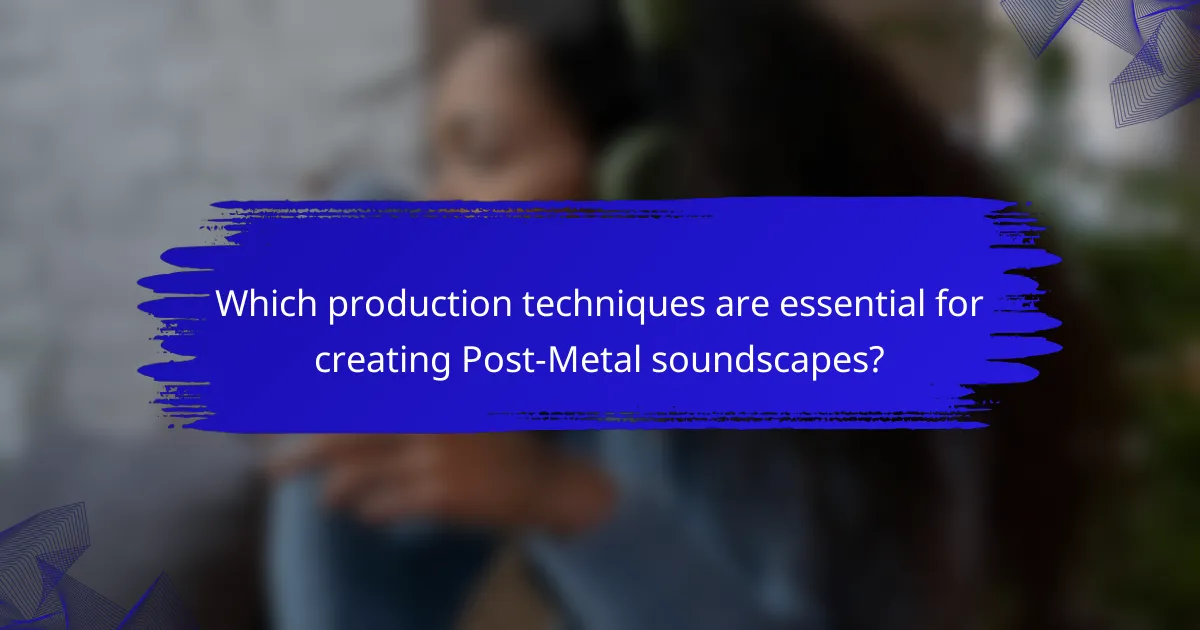
Which production techniques are essential for creating Post-Metal soundscapes?
Creating Post-Metal soundscapes requires essential production techniques such as layering, reverb, and dynamic contrast. Layering involves stacking multiple guitar tracks to create a rich texture. Reverb adds depth, enhancing the atmospheric quality of the sound. Dynamic contrast is crucial for building tension and release, often achieved through varying the intensity of instrumentation. These techniques collectively contribute to the immersive experience characteristic of Post-Metal.
How does layering contribute to the depth of sound?
Layering enhances sound depth by creating complex textures and dynamics. In post-metal fusion, multiple instrumental layers intertwine, producing rich soundscapes that evoke emotional responses. This technique allows for gradual build-ups and contrasts, contributing to immersive listening experiences. Influential releases demonstrate how effective layering can transform simple melodies into expansive auditory journeys, showcasing the genre’s unique attributes.
What role do effects and technology play in shaping the genre’s sound?
Effects and technology significantly shape post-metal fusion’s sound by enhancing atmospheric depth and sonic complexity. Effects like reverb and delay create expansive soundscapes, while innovative technology allows for intricate layering and manipulation of sound. Influential releases often showcase these elements, demonstrating how digital tools and analog techniques blend to produce unique auditory experiences. The use of guitar pedals, synthesizers, and digital audio workstations has become essential in crafting the genre’s distinctive sound. This evolution highlights a unique attribute of post-metal fusion: its adaptability and integration of diverse influences through technological advancements.
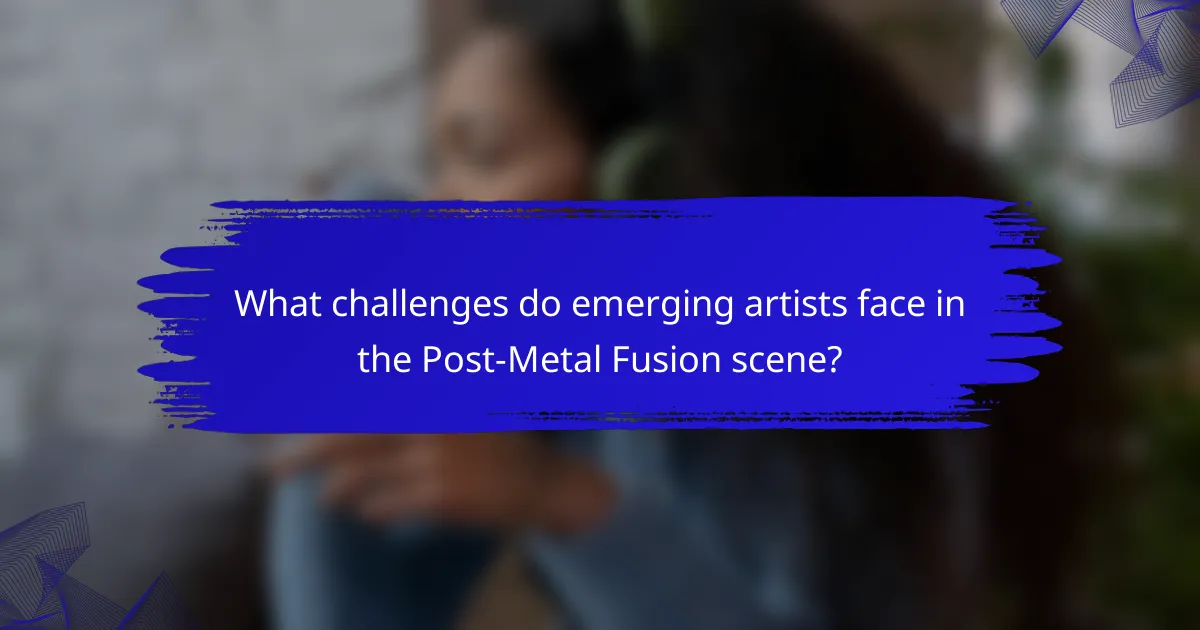
What challenges do emerging artists face in the Post-Metal Fusion scene?
Emerging artists in the Post-Metal Fusion scene face significant challenges including limited exposure, financial instability, and a saturated market. The unique soundscapes they create can be difficult to promote, often overshadowed by more established genres. Additionally, securing venues and audiences for performances proves challenging due to competition from mainstream acts. Access to resources for recording and production is often restricted, impacting their ability to produce high-quality releases. Networking within the industry remains crucial yet challenging, as many emerging artists lack connections to influential figures.
How can new bands navigate the complexities of genre blending?
New bands can navigate genre blending by embracing experimentation and collaboration. Post-metal fusion encourages diverse soundscapes that combine elements from various genres, creating rich auditory experiences. Influential releases, such as those by bands like Neurosis or Cult of Luna, showcase successful genre integration. These bands often incorporate atmospheric elements and heavy instrumentation, allowing new artists to draw inspiration while developing their unique sound.
What are common pitfalls to avoid in the early stages of a Post-Metal career?
Common pitfalls in the early stages of a Post-Metal career include lack of a distinct sound, neglecting live performances, and insufficient networking. Emerging artists often struggle to define their unique soundscape, leading to generic music that fails to stand out. Ignoring the importance of live shows can hinder audience connection and growth. Additionally, underestimating the value of building relationships within the music community can limit opportunities for collaboration and exposure.
What strategies can help artists gain visibility in a saturated market?
Artists can gain visibility in a saturated market by leveraging unique soundscapes and post-metal fusion elements. Collaborating with other artists can expand reach and introduce new audiences. Utilizing social media platforms effectively helps in engaging potential fans and sharing influential releases. Participating in niche festivals or events allows artists to showcase their work to targeted audiences who appreciate their genre. Creating visually compelling content, such as music videos or artwork, enhances brand identity and attracts attention. Engaging with online communities and forums related to post-metal can foster connections and increase visibility.
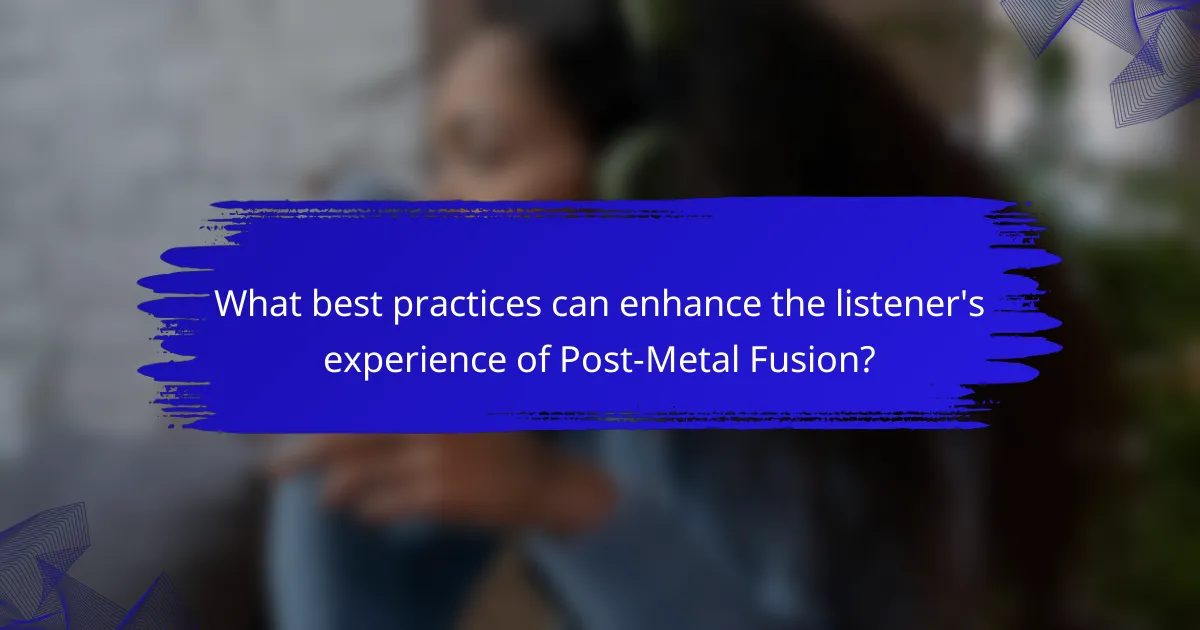
What best practices can enhance the listener’s experience of Post-Metal Fusion?
To enhance the listener’s experience of Post-Metal Fusion, focus on immersive soundscapes and dynamic contrasts. Incorporating atmospheric elements creates depth, while varied tempos maintain engagement. Pay attention to production quality, ensuring clarity and richness in sound. Collaborative projects with diverse influences can introduce unique textures, enriching the overall auditory experience.
How can live performances be optimized for maximum impact?
Live performances can be optimized by enhancing soundscapes, engaging the audience, and utilizing innovative technology. Incorporating immersive audio-visual elements creates a unique experience that resonates emotionally. For instance, layering post-metal fusion elements can deepen the atmosphere and captivate listeners.
Utilizing dynamic lighting and stage design can amplify the overall impact. Integrating audience participation through interactive elements fosters a connection, making the performance memorable. Additionally, leveraging high-quality sound systems ensures clarity and richness in sound, crucial for post-metal fusion genres.
Regularly analyzing audience feedback can inform adjustments for future performances. Creating a cohesive narrative throughout the set can maintain engagement and enhance the emotional journey. These strategies collectively elevate live performances, ensuring they leave a lasting impression.
What listening environments best suit Post-Metal soundscapes?
Post-metal soundscapes thrive in immersive environments that enhance their atmospheric qualities. Ideal settings include concert halls, outdoor festivals, and intimate venues. These spaces amplify the genre’s layered instrumentation and emotional depth. Additionally, natural landscapes like forests or mountains provide a unique backdrop, allowing the music to resonate with the surroundings.